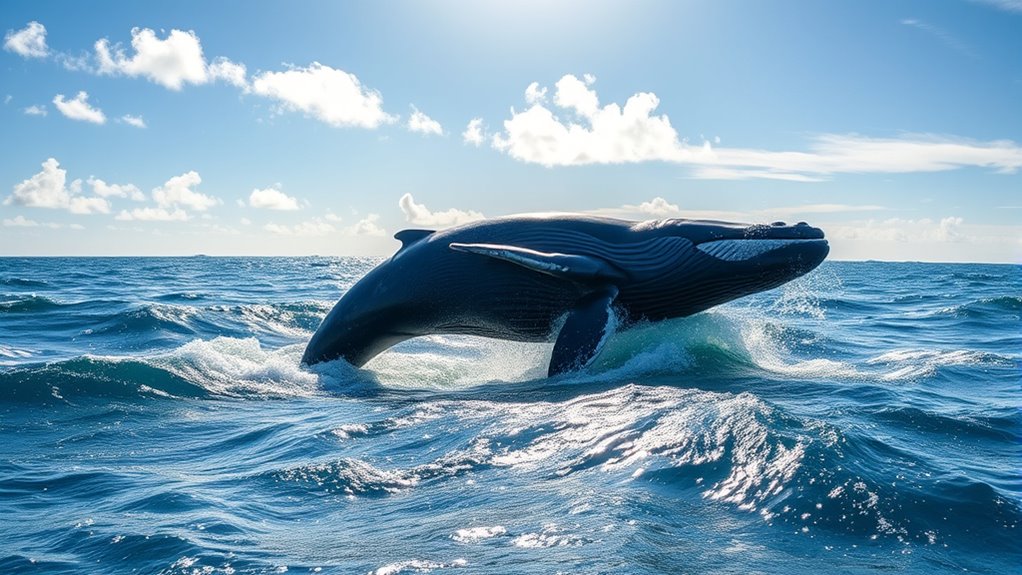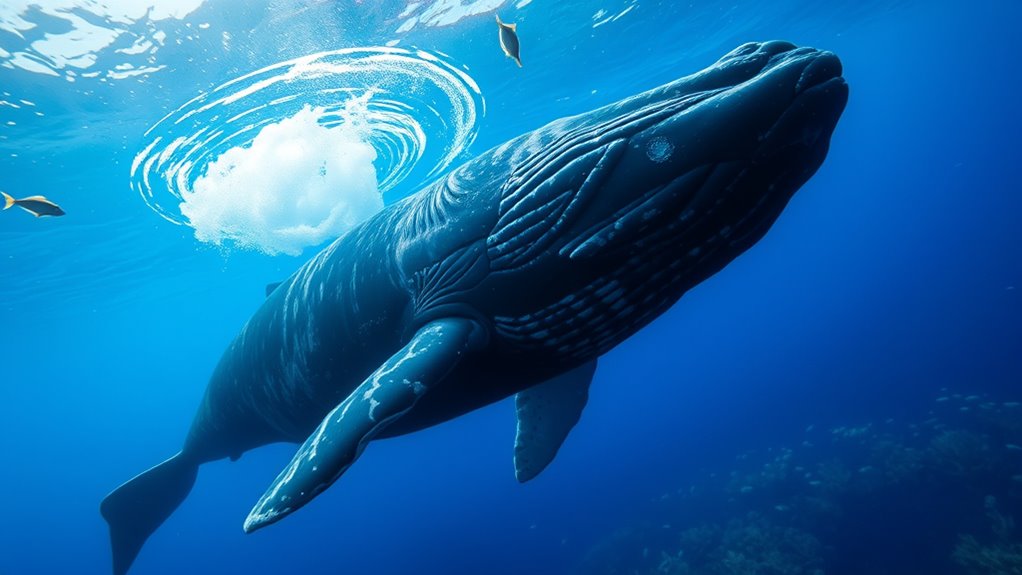Scientists recording unusual whale sounds in the Pacific Ocean have captured vocalizations that don’t match typical whale patterns. These complex, irregular sounds suggest whales might be communicating in new ways or responding to environmental changes, possibly due to noise pollution or climate impacts. Such anomalies could indicate stress or shifts in whale behavior, offering clues about ocean health. Stay with us to uncover what these mysterious sounds reveal about our changing marine world.
Key Takeaways
- Recorded whale sounds display irregular patterns and pitch shifts that differ from typical whale vocalizations.
- Such acoustic anomalies may indicate new communication behaviors or responses to environmental stressors.
- External factors like noise pollution or climate change could be influencing whale sound patterns.
- These unusual sounds serve as vital indicators of ecosystem health and potential threats to marine life.
- Advanced acoustic analysis suggests the need for further research to interpret the signals’ meanings.

Have you ever heard a whale song that sounds completely different from what you’re used to? If so, you might have wondered what it means or why it’s so unusual. Recently, scientists recorded a series of vocalizations from whales in the Pacific Ocean that defy typical expectations, sparking curiosity and debate. These sounds don’t fit the usual patterns of marine communication, and their acoustic anomalies have left researchers puzzled. Normally, whale songs are rhythmic, repetitive, and serve specific purposes like mating or navigation. But this new recording features irregular patterns, unexpected pitch shifts, and complex sequences that don’t match known vocal behaviors. It’s as if the whales are trying to communicate something entirely novel or are responding to an unfamiliar stimulus.
What makes this even more intriguing is that these acoustic anomalies might suggest a shift in how whales use sound to communicate. Marine communication relies heavily on sound because light doesn’t penetrate deep into the ocean. Whales, as highly social animals, depend on their vocalizations to stay connected over vast distances. When those sounds change unexpectedly, it raises questions about what’s influencing them. Are these whales experiencing environmental stress, or could they be affected by human-made noise pollution? Or maybe they’re trying to send a message that’s different from their usual calls—perhaps a sign of distress, a new social behavior, or even an attempt to establish new territory. Additionally, these anomalies could be linked to AI-driven monitoring technologies that help researchers analyze complex acoustic data more effectively. Moreover, the presence of noise pollution in marine environments could be a contributing factor to these unusual sounds.
Furthermore, understanding these unusual sounds can provide insights into marine ecosystem health, indicating broader environmental changes or threats. As you consider these possibilities, it’s important to recognize how unusual acoustic anomalies can signal broader changes in the ocean ecosystem. Scientists track these variations carefully because they can indicate shifts in whale populations or environmental conditions. Such anomalies might be caused by external factors like increased ship traffic, sonar activity, or climate change impacting their habitat. Alternatively, they might represent an evolutionary adaptation, a new form of marine communication that scientists haven’t encountered before. Whatever the cause, these strange sounds highlight how much there is still to learn about whale behavior and the complex ways they use sound in their daily lives.
You can imagine how these discoveries push the boundaries of current knowledge. Each new recording challenges existing assumptions and urges scientists to investigate further. They might deploy more advanced underwater microphones or analyze the frequency and structure of these calls to decipher their meaning. In the end, these acoustic anomalies remind us that the ocean remains a vast, largely uncharted world filled with mysteries. Understanding whale communication better could help protect these magnificent creatures and preserve the delicate balance of marine ecosystems for generations to come.
Frequently Asked Questions
What Species of Whale Produced the Unusual Song?
You might wonder which species produced the unusual whale song. Acoustic analysis suggests it was likely a humpback whale, known for complex vocalizations. This discovery has important biological implications, as it could indicate new communication behaviors or adaptations. By studying these sounds, you can better understand whale social structures and migration patterns. Such findings deepen your knowledge of marine life, highlighting the importance of ongoing acoustic research in revealing hidden aspects of whale behavior.
How Long Has This Type of Whale Singing Been Documented?
You might wonder how long this whale singing has been documented. Researchers have recorded similar songs for several decades, revealing the cultural significance of these vocalizations among whale populations. Using advanced acoustic technology, scientists can analyze these sounds in detail. This ongoing documentation helps us understand whale communication and behavior, emphasizing the importance of protecting these remarkable creatures and their intricate acoustic traditions that span generations.
Could This Song Indicate a New Whale Species?
Think of this song as a secret code echoing through the ocean’s depths. You might wonder if it signals a new whale species, as their marine communication often has unique acoustic signatures. While it’s tempting to jump to conclusions, scientists need more evidence before claiming a new species. For now, this mysterious song keeps the ocean’s conversations intriguing, highlighting how much there still is to discover about marine communication.
Are There Any Known Predators Attracted by the Song?
You wonder if marine acoustic signals, like this unusual whale song, attract predators. It’s possible because some predators, such as killer whales, use acoustic cues to find prey. If the song’s frequency or pattern resembles distress signals or prey sounds, it might increase predator attraction. Scientists are studying these sounds to understand better how marine acoustic signals influence predator behavior and whether this affects whale safety in their environment.
How Might This Discovery Impact Marine Conservation Efforts?
You might realize that this discovery could considerably influence marine policy by highlighting the importance of acoustic monitoring. By understanding unique whale songs, you help advocate for better protection measures, ensuring their habitats are preserved. This research underscores the need for improved regulations on noise pollution, which can disrupt communication. Your support for acoustic monitoring efforts could lead to more effective conservation strategies, safeguarding these essential marine species for future generations.
Conclusion
You see, just like a closed book with many pages yet to be read, the ocean still holds many secrets. This mysterious whale song reminds us that nature’s puzzles are never fully solved. Keep exploring and questioning, because every discovery opens new doors. As the saying goes, “The more we learn, the more we realize how much we don’t know.” So, stay curious—there’s always more wonder waiting beneath the waves.









